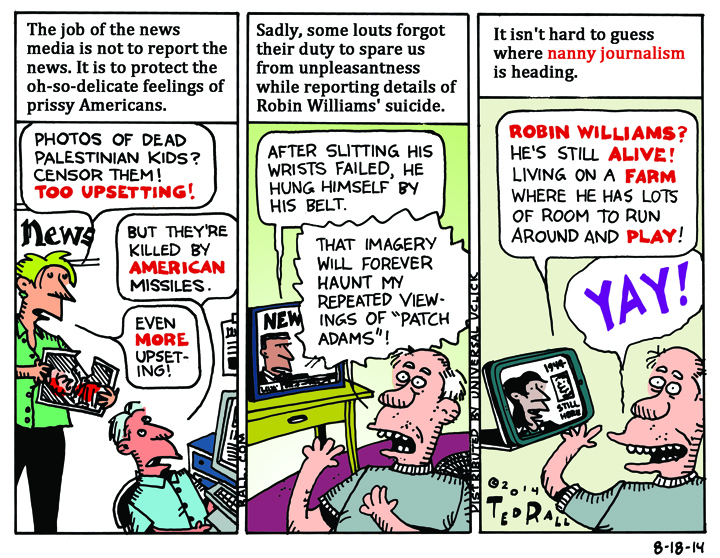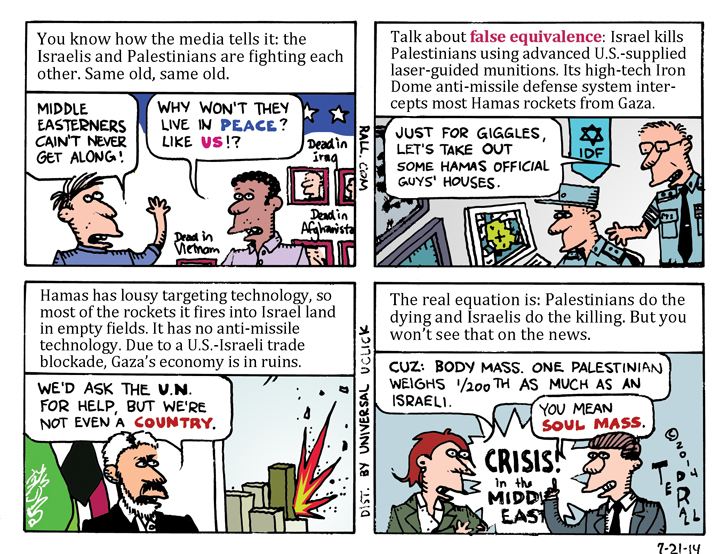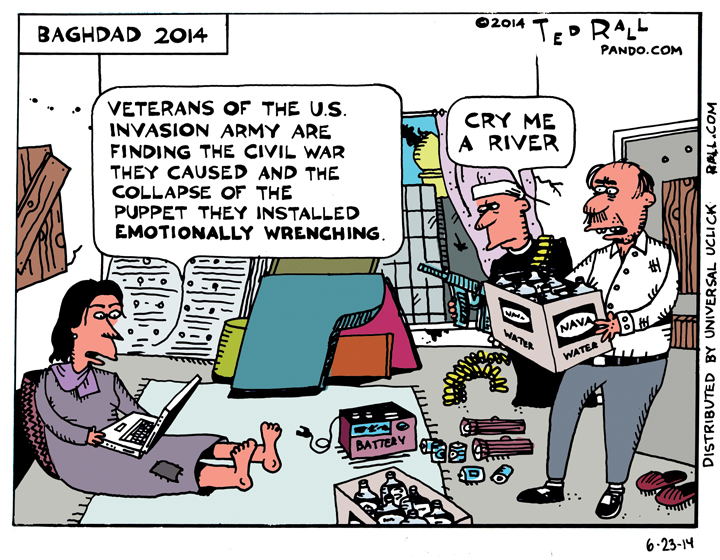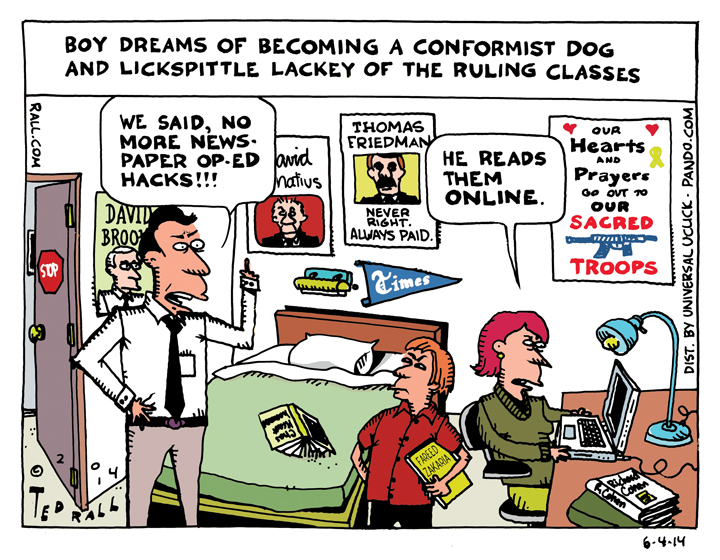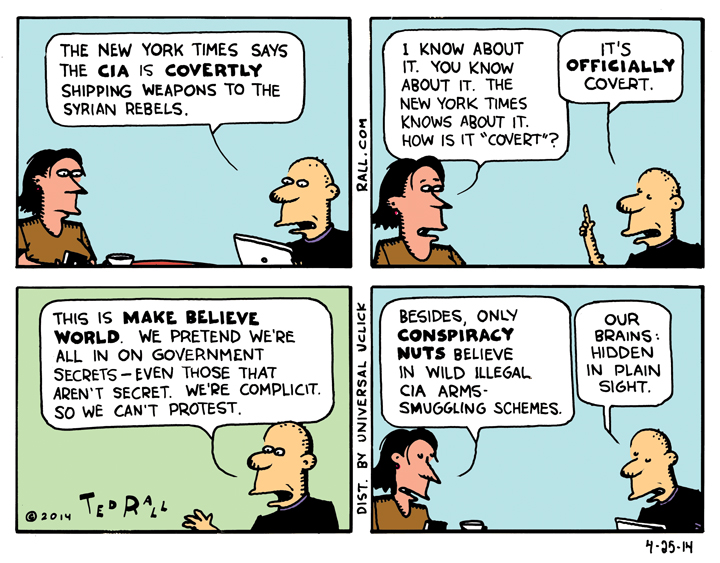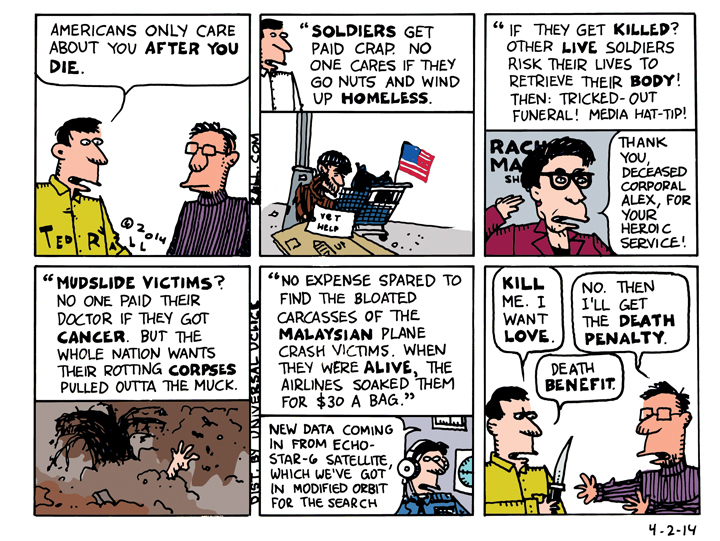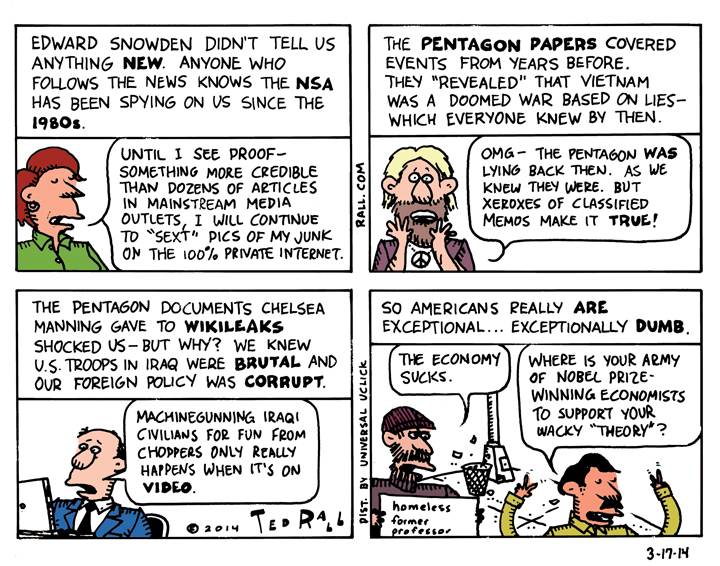The Charlie Hebdo massacre couldn’t have happened here in the United States. But it’s not because American newspapers have better security.
Gunmen could never kill four political cartoonists in an American newspaper office because no paper in the U.S. employs two, much less four, staff political cartoonists — the number who died Wednesday in Paris. There is no equivalent of Charlie Hebdo, which puts political cartoons front and center, in the States. (The Onion never published political cartoons — and it ceased print publication last year. MAD, for which I draw, focuses on popular culture.)
When I began drawing political cartoons professionally in the early 1990s, hundreds of my colleagues worked on staff at newspapers, with full salaries and benefits. That was already down from journalism’s mid-century glory days, when there were thousands. Many papers employed two. Shortly after World War II, The New York Times, which today has none, employed four cartoonists on staff. Today there are fewer than 30.
Most American states have zero full-time staff political cartoonists.
Many big states — California, New York, Texas, Illinois — have one.
No American political magazine, on the left, center or right, has one.
No American political website (Huffington Post, Talking Points Memo, Daily Kos, Slate, Salon, etc.) employs a political cartoonist. Although its launch video was done in cartoons, eBay billionaire Pierre Omidyar’s new $250 million left-wing start-up First Look Media refuses to hire political cartoonists — or pay tiny fees to reprint syndicated ones.
These outfits have tons of staff writers.
During the last few days, many journalists and editors have spread the “Je Suis Charlie” meme through social media in order to express “solidarity” with the victims of Charlie Hebdo, political cartoonists (who routinely receive death threats, whether they live in France or the United States) and freedom of expression. That’s nice.
No it’s not.
It’s annoying.
As far as political cartoonists are concerned, editorials pledging “solidarity” with the Charlie Hebdo cartoonists is an empty gesture — corporate slacktivism. Less than 24 hours after the shootings at Charlie Hebdo, the Fort Lauderdale Sun-Sentinel fired its long-time, award-winning political cartoonist, Chan Lowe.
Political cartoonists: editors love us when we’re dead. While we’re still breathing, they’re laying us off, slashing our rates, stealing our copyrights and disappearing us from where we used to appear — killing our art form.
American editors and publishers have never been as willing to publish satire, whether in pictures or in words, as their European counterparts. But things have gone from bad to apocalyptic in the last 30 years.
Humor columnists like the late Art Buchwald earned millions syndicating their jokes about politicians and current events to American newspapers through the 1970s and 1980s. Miami Herald humor writer Dave Barry was a rock star through the 1990s, routinely cranking out bestselling books. Then came 9/11.
When I began working as an executive talent scout for the United Media syndicate in 2006, my sales staff informed me that, if Barry had started out then, they wouldn’t have been able to sell him to a single newspaper, magazine or website — not even if they gave his work to them for free. Barry was still funny, but there was no market for satire anywhere in American media.
That’s even truer today.
The youngest working political cartoonist in the United States, Matt Bors, is 31. When people ask me who the next up-and-comer is, I tell them there isn’t one — and there won’t be one any time soon.
Americans are funny. Americans like funny. They especially like wicked funny. We’re so desperate for funny that we think Jon Stewart is hilarious. (But…Richard Pryor. He really was.) But editors and producers won’t give them funny, much less mean-funny.
Why not?
Like any other disaster, media censorship of satire — especially graphic satire — in the U.S. is caused by several contributing factors.
Most media outlets are owned by corporations, not private owners. Publicly-traded companies are risk-averse. Executives prefer to publish boring/safe content that won’t generate complaints from advertisers or shareholders, much less force them to hire extra security guards.
Half a century ago, many editors had working-class backgrounds and rose through the ranks from the bottom. Now they’re graduates of pricey graduate university journalism programs that don’t offer scholarships — and don’t teach a single class about comics, cartoons, humor or graphic art. It takes an unusually curious editor to make the effort to educate himself or herself about political cartoons.
Corporate journalism executives view cartoons as frivolous, less serious than “real” commentary like columns or editorials. Unfortunately, some editorial cartoonists make this problem worse by drawing silly gags about current events (as opposed to trenchant attacks on the powers that be) because they’ve seen their blandest work win Pulitzers and coveted spots in the major weekend cartoon “round-ups.” When asked to cut their budget, editors often look at their cartoonist first.
There is still powerful political cartooning online. Ironically, the Internet contributes to the death of satire in America by sating the demand for hard-hitting political art. Before the Web, if a paper canceled my cartoons they would receive angry letters from my fans. Now my readers find me online — but the Internet pays pennies on the print dollar. I’m stubbornly hanging on, but many talented cartoonists, especially the young, won’t work for free.
It’s not that media organizations are broke. Far from it. Many are profitable. American newspapers and magazines employ tens of thousands of writers — they just don’t want anyone writing or drawing anything that questions the status quo, especially not in a form as powerful as political cartooning.
The next time you hear editors pretending to stand up for freedom of expression, ask them if they employ a cartoonist.
(Ted Rall, syndicated writer and cartoonist for The Los Angeles Times, is the author of the new critically-acclaimed book “After We Kill You, We Will Welcome You Back As Honored Guests: Unembedded in Afghanistan.” Subscribe to Ted Rall at Beacon.)
COPYRIGHT 2015 TED RALL, DISTRIBUTED BY CREATORS.COM


